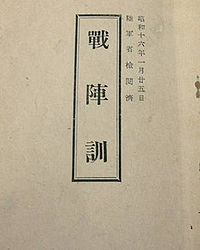
Senjinkun military code
Encyclopedia

Imperial Japanese forces
For Imperial Japanese Forces, see* Imperial Japanese Army* Imperial Japanese NavyAir Forces were part of the Army or Navy....
on 8 January 1941 in the name of then War Minister
Ministry of War of Japan
The , more popularly known as the Ministry of War of Japan, was cabinet-level ministry in the Empire of Japan charged with the administrative affairs of the Imperial Japanese Army...
Hideki Tojo
Hideki Tōjō
Hideki Tōjō was a general of the Imperial Japanese Army , the leader of the Taisei Yokusankai, and the 40th Prime Minister of Japan during most of World War II, from 17 October 1941 to 22 July 1944...
. It was in use at the outbreak of the Pacific War
Pacific War
The Pacific War, also sometimes called the Asia-Pacific War refers broadly to the parts of World War II that took place in the Pacific Ocean, its islands, and in East Asia, then called the Far East...
.
The Senjinkun was regarded as a supplement to the Imperial Rescript to Soldiers and Sailors
Imperial Rescript to Soldiers and Sailors
The was issued by Emperor Meiji of Japan on 4 January 1882.It was the most important document in the development of the Imperial Japanese Army and Imperial Japanese Navy.-Details:...
, which was already required reading for the Japanese military. It listed a number of exhortations regarding military regulations, combat readiness, esprit de corps, filial piety, veneration of Shinto
Shinto
or Shintoism, also kami-no-michi, is the indigenous spirituality of Japan and the Japanese people. It is a set of practices, to be carried out diligently, to establish a connection between present day Japan and its ancient past. Shinto practices were first recorded and codified in the written...
kami
Kami
is the Japanese word for the spirits, natural forces, or essence in the Shinto faith. Although the word is sometimes translated as "god" or "deity", some Shinto scholars argue that such a translation can cause a misunderstanding of the term...
, and Japan's kokutai
Kokutai
Kokutai is a politically loaded word in the Japanese language, translatable as "sovereign", "national identity; national essence; national character" or "national polity; body politic; national entity; basis for the Emperor's sovereignty; Japanese constitution". "Sovereign" is perhaps the most...
. The code specifically forbade retreat or surrender. The quote "Never live to experience shame as a prisoner." was repeatedly cited as the cause of numerous suicides committed by soldiers and civilians.
Japanese soldiers were instructed to “show mercy to those who surrender”. This was written in response to prior misconduct on the battlefield.
Towards the end of the war, copies of the Senjinkun were also distributed to the civilian population of Japan as part of the preparation for Operation Downfall
Operation Downfall
Operation Downfall was the Allied plan for the invasion of Japan near the end of World War II. The operation was cancelled when Japan surrendered after the atomic bombing of Hiroshima and Nagasaki and the Soviet Union's declaration of war against Japan. The operation had two parts: Operation...
, the expected invasion of the Japanese home islands by Allied forces
Allies of World War II
The Allies of World War II were the countries that opposed the Axis powers during the Second World War . Former Axis states contributing to the Allied victory are not considered Allied states...
.
Excerpt from the Senjinkun introduction
- The battlefield is where the Imperial Army, acting under the Imperial Command, displays its true character, conquering whenever it attacks, winning whenever it engages in combat, in order to spread the Imperial Way far and wide so that the enemy may look up in awe to the august virtues of His Majesty.
- The Imperial Rescript to the armed forces is explicit while the regulations and manuals clearly define conduct in combat and methods of training. Conditions in the zone of combat, however, tend to cause soldiers to be swayed by immediate events and become forgetful of their duties. Indeed, they should be wary there, lest they run counter to their duties as soldiers. The purpose of the present Code lies in providing concrete rules of conduct, in the light of past experience, so that those in zones of combat may wholly abide by the Imperial Rescript and enhance the moral virtues of the Imperial Army.
Subsequent chapters
- The Empire
- Discipline
- Unity
- Co-operation
- Aggressiveness
- The Conviction to Win
- Piety
- Filial Piety
- Salutes and Manners
- The Way of Comrades in Arms
- Initiative in Exemplary Conduct
- Responsibility
- Views on Life and Death
- Honor
- Simplicity and Fortitude
- Integrity
- Counsel Concerning Field Service
- Achievements of Soldiers in the Field
- Conclusion
Related works
A similar military code titled Precepts Concerning the Decisive Battle was issued by War Minister Korechika Anami on 1945-04-08. The Precepts stipulated that Imperial Japanese ArmyImperial Japanese Army
-Foundation:During the Meiji Restoration, the military forces loyal to the Emperor were samurai drawn primarily from the loyalist feudal domains of Satsuma and Chōshū...
officers and men should:
- (1) obey the Imperial Rescript to Soldiers and SailorsImperial Rescript to Soldiers and SailorsThe was issued by Emperor Meiji of Japan on 4 January 1882.It was the most important document in the development of the Imperial Japanese Army and Imperial Japanese Navy.-Details:...
and proceed to abide by the Imperial Will - (2) defend Imperial soil to the last
- (3) await the future, after preparations have been effected
- (4) possess a deep-seated spirit of ramming suicide
- (5) set the example for 100,000,000 compatriots.

